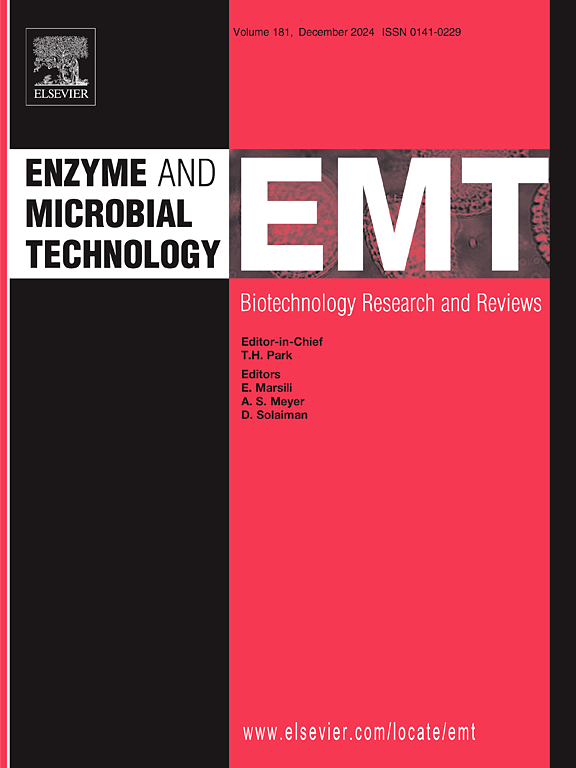蛋白胨源对酵母重组蛋白酶生产和细胞反应的影响
IF 3.7
3区 生物学
Q2 BIOTECHNOLOGY & APPLIED MICROBIOLOGY
引用次数: 0
摘要
重组蛋白酶的生产因其广泛的工业应用而至关重要。本研究探讨了发酵培养基中蛋白胨转换对重组蛋白酶生产和细胞代谢的影响。以酵母酵母(Saccharomyces cerevisiae)为表达宿主,比较其在YPD培养基(含细菌蛋白胨)和YTD培养基(含色氨酸)中的生长和蛋白酶活性。蛋白酶产生菌株B_lasB2从细菌性蛋白胨转换为色氨酸导致细胞密度增加35.22%,尽管蛋白酶活性仍未检测到。蛋白胨转换还导致肉汤的颜色从淡黄色明显转变为棕黄色,在删除蘑菇酪氨酸酶的同源基因FET3及其复合物FTR1后,这种转变被逆转。Western blot分析证实该蛋白酶被合成,但仍处于失活状态。RNA测序揭示了响应蛋白胨转换的转录谱的实质性变化。在YTD培养基中,主要位于内质网管腔的参与蛋白质折叠的基因显著上调。相反,在YPD培养基中,发生了显著的下调,影响线粒体内参与线粒体翻译的基因。这些发现表明,蛋白胨转换不仅影响细胞生长和酶活性,还会引起酵母转录环境的显著变化。这项研究为酵母在不同发酵条件下的代谢调节提供了更深入的见解,并强调了蛋白胨来源、蛋白酶产生和蛋白酶活性之间的复杂关系。本文章由计算机程序翻译,如有差异,请以英文原文为准。
Peptone source effects on recombinant protease production and cellular responses in yeast
The production of recombinant protease is critical due to their wide range of industrial applications. This study investigates the impact of the peptone switching in the fermentation media on recombinant protease production and cell metabolism. The yeast Saccharomyces cerevisiae was used as the expression host, comparing growth and protease activity in YPD medium (containing bacteriological peptone) and a modified version, YTD medium (containing tryptone). Switching from bacteriological peptone to tryptone resulted in a 35.22% increase in cell density for the protease-producing strain B_lasB2, although protease activity remained undetectable. Peptone switching also resulted in a noticeable shift in broth color from pale yellow to brownish yellow, which was reversed upon deletion of the FET3 gene, a homolog of mushroom tyrosinase, and its complex FTR1. Western blot analysis confirmed that the protease was synthesized but remained in an inactive form. RNA sequencing revealed substantial shifts in transcriptional profiles in response to peptone switching. In YTD medium, there was a predominant upregulation of genes involved in protein folding, primarily located in the endoplasmic reticulum lumen. Conversely, in YPD medium, significant downregulation occurred, affecting genes involved in mitochondrial translation and located within the mitochondria. These findings highlight that peptone switching not only affects cell growth and enzyme activity but also induces significant changes in the yeast’s transcriptional landscape. This study provides deeper insights into the metabolic adjustments that yeast undergoes in different fermentation conditions and underscores the complex relationship between peptone source, protease production, and protease activity.
求助全文
通过发布文献求助,成功后即可免费获取论文全文。
去求助
来源期刊

Enzyme and Microbial Technology
生物-生物工程与应用微生物
CiteScore
7.60
自引率
5.90%
发文量
142
审稿时长
38 days
期刊介绍:
Enzyme and Microbial Technology is an international, peer-reviewed journal publishing original research and reviews, of biotechnological significance and novelty, on basic and applied aspects of the science and technology of processes involving the use of enzymes, micro-organisms, animal cells and plant cells.
We especially encourage submissions on:
Biocatalysis and the use of Directed Evolution in Synthetic Biology and Biotechnology
Biotechnological Production of New Bioactive Molecules, Biomaterials, Biopharmaceuticals, and Biofuels
New Imaging Techniques and Biosensors, especially as applicable to Healthcare and Systems Biology
New Biotechnological Approaches in Genomics, Proteomics and Metabolomics
Metabolic Engineering, Biomolecular Engineering and Nanobiotechnology
Manuscripts which report isolation, purification, immobilization or utilization of organisms or enzymes which are already well-described in the literature are not suitable for publication in EMT, unless their primary purpose is to report significant new findings or approaches which are of broad biotechnological importance. Similarly, manuscripts which report optimization studies on well-established processes are inappropriate. EMT does not accept papers dealing with mathematical modeling unless they report significant, new experimental data.
 求助内容:
求助内容: 应助结果提醒方式:
应助结果提醒方式:


